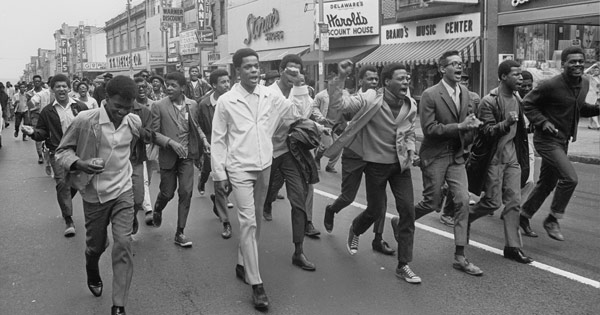


Day of Remembrance
Photo courtesy of The News Journal April 05, 2018
Program honors Martin Luther King Jr., recalls 1968 Wilmington
Delawareans who were high school or college students, National Guard members and those not yet born 50 years ago gathered at the University of Delaware on April 4 to share memories, grief and tributes to the Rev. Dr. Martin Luther King Jr.
The occasion was “A Day of Remembrance in Pictures and Words,” hosted by UD’s Department of Africana Studies in Trabant University Center Theatre.
Part of a nationwide network of memorial events held on the 50-year anniversary of King’s assassination, the UD program also recalled the unique nature of 1968 Wilmington.
That April, Delaware’s largest city experienced two days of unrest, looting and vandalism—which historians note was short-lived and much less severe than riots in many other cities—but Delaware National Guard troops patrolled in Wilmington for the next nine months. It would be the longest military occupation of a U.S. city since the Civil War.
Margaret Winslow, a curator at the Delaware Art Museum and an instructor in Africana studies at UD who is teaching a class that is conducting research into the events of 1968 in Delaware, welcomed the audience to the “Day of Remembrance” event. She called the assassination of Dr. King “one of the most significant and heartbreaking events of the 20th century.”
Speakers who experienced that time shared similar thoughts.
As a teenager living in the Dunleith community just south of Wilmington, “I was absolutely heartbroken on April 4, 1968,” said Norma Gaines-Hanks, associate professor of human development and family science at UD. “My spirit was sapped away from me that day. … I had no idea it would still haunt me today.”
Gaines-Hanks spoke as part of a panel that also included UD alumni Ron Whittington ’71, R.W. Buck Simpers ’73 and Leo Tammi ’69, all students at the University in 1968, and photographers Fred Comegys and Chuck McGowen, who worked for The (Wilmington) News Journal at the time.
Although Whittington stayed on campus during summer 1968 at his parents’ insistence, he recalled visiting Wilmington with two friends one Saturday and being chased by police as they walked along Market Street. The three African American men then returned to Newark and were chased by police there, said Whittington, who is now a retired UD administrator and teaches an Honors class as an adjunct faculty member.
Tammi, a photography enthusiast then and now, also ventured from the UD campus to Wilmington and captured images of the city and its people, many going about their daily lives despite the tumultuous events of the time.
“I was just struck by the humanity on the streets,” said Tammi, who was an early member of the activist Students for a Democratic Society (SDS) chapter at UD. Whittington remembered Tammi and fellow SDS members advising him and others as they worked to form the first Black Student Union at the University in 1968.
Simpers was not only a UD student at the time but also a member of the Delaware National Guard and, like other Guard members that year, spent his weeks of summer duty stationed in Wilmington. As a white teenager, he said, he had first been exposed to the realities of racism in Delaware when he worked for an African American architect, an experience he said “really opened my eyes” to injustice.
Posted throughout Wilmington at key commercial buildings, reservoirs and other potential targets of vandalism, Simpers said he had the same thoughts as most of his fellow National Guard troops: “Nobody wanted to be there,” he said.
Whittington and Gaines-Hanks, both of whose families lived in Wilmington, described the initial unrest there as much less widespread and lethal than it was perceived at the time by mostly white suburbanites and the state’s “law-and-order” governor. While racism, poverty and inequality had persisted in Delaware, little had been done to understand the frustration or improve the situation of African Americans, they said.
“Don’t be upset by the protests,” Gaines-Hanks said, referring to both 1968 and today’s social justice activism. “Be upset by why the protests happened.”
McGowen and Comegys talked about their work as photographers in 1968 and about the many photos believed to be lost whose negatives were only recently discovered by The News Journal in its archives. Those images will be the basis of an exhibit opening this summer at the Delaware Art Museum, with research conducted by UD history graduate student Simone Austin and with assistance from Winslow’s class.
The “Day of Remembrance” also featured poetry by Delaware poet laureate Albert Mills, who read his “68 in My City,” and a performance that gave the audience a look into the creative process of storyteller TAHIRA and singer/songwriter Jea Street Jr. Street and TAHIRA are collaborating on three pieces, commissioned by the Delaware Art Museum.
The event was sponsored by UD’s Partnership for Arts and Culture, with participation by the Delaware Art Museum and the state Division of the Arts.
About an hour into the event, the UD Carillon tolled across campus in memory of Dr. King and his call to “let freedom ring.” The bells on campus, and across the U.S., rang 39 times, once for each year of his life.
Contact Us
Have a UDaily story idea?
Contact us at ocm@udel.edu
Members of the press
Contact us at 302-831-NEWS or visit the Media Relations website

